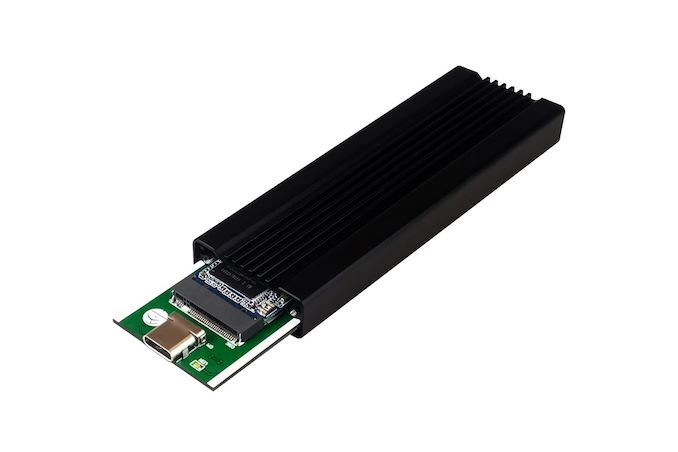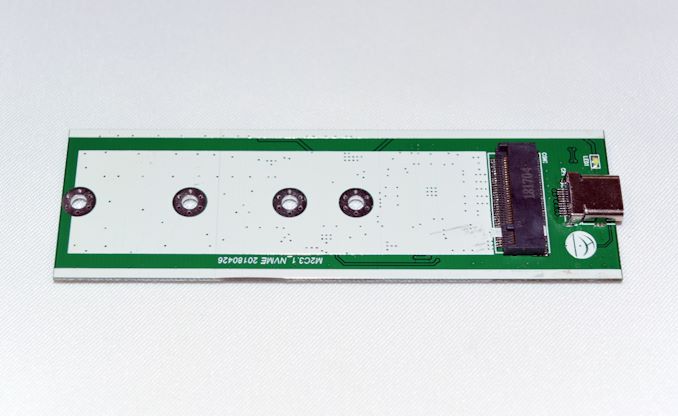MyDigitalSSD M2X M.2 NVMe SSD Enclosure Review - A PCIe to USB Storage Bridge
by Ganesh T S on October 31, 2018 8:00 AM EST- Posted in
- Storage
- SSDs
- USB 3.1
- NVMe
- Type-C
- Storage Bridge
- External SSDs

Storage bridges come in many varieties within the internal and external market segments. USB has become the de-facto standard when it comes to external mass-market storage enclosures. But while there are plenty of options to bridge SATA devices in different form factors to USB, the rapid rise in popularity of NVMe drives has brought about a different challenge. In the premium market, we have many Thunderbolt 3 external SSDs with M.2 NVMe drives inside. However for various reasons, the development of NVMe-to-USB adapters has been another matter.
In fact it's only recently that we've finally seen some progress on this front. JMicron's introduction of a PCIe 3.0 x2 to USB 3.1 Gen 2 bridge chip (JMS583) has enabled Asian OEMs to introduce bus-powered NVMe SSD enclosures with a USB interface, finally enabling relatively cheap USB adapters for NVMe drives. MyDigitalSSD, in turn, is one of the first to bring such a device to the North American market with their M2X External USB 3.1 Gen 2 M.2 NVMe PCIe SSD Enclosure Adapter.
Introduction
The external storage bridges that we have evaluated so far have usually had one or more SATA ports. The most popular uplink port is some sort of USB connection. eSATA as an uplink interface is on the way out. High-end products have Thunderbolt support. The introduction of PCIe to USB bridge chips such as the JMicron JMS583 and the ASMedia ASM2362 have now brought M.2 PCIe slots as a downstream option.
Today's review will take a detailed look at the MyDigitalSSD M2X external USB 3.1 Gen 2 M.2 NVMe PCIe SSD enclosure adapter, an interesting product with a mouthful of a name that's based based on the JMicron JMS583 bridge chip.
In order to ensure compatibility across a wide variety of systems, consumers need to keep the following aspects in mind for M.2 NVMe to USB enclosures and SSDs used inside them:
- Support for UASP (USB-attached SCSI protocol) for better performance (reduced protocol overhead and support for making optimal use of the NVMe command set)
- Support for TRIM to ensure SSDs in the external enclosure can operate optimally in the long run
- Support for S.M.A.R.T passthrough to enable monitoring of the internal NVMe device by the host OS
- Ability of the chosen SSD to expose an active power state that doesn't exceed 4.5W after adding the bridge chip's power consumption into account
The table below presents the detailed specifications and miscellaneous aspects of the various storage bridges we have evaluated so far and how they compare.
| Comparative Storage Bridges Configurations | ||
| Aspect | ||
| Downstream Port | 1x PCIe 3.0 x2 (M.2 NVMe) | 1x SATA III (mSATA) |
| Upstream Port | USB 3.1 Gen 2 Type-C | USB 3.1 Gen 2 Type-C |
| Bridge Chip | JMicron JMS583 | ASMedia ASM1351 |
| Power | Bus Powered | Bus Powered |
| Use Case | M.2 2242 / 2260 / 2280 NVMe SSD Enclosure DIY high-performance, compact, and sturdy portable SSD with a USB flash drive-like form-factor |
mSATA SSD Enclosure DIY high-performance, compact, and sturdy portable SSD with a USB flash drive-like form-factor |
| Physical Dimensions | 99 mm x 42 mm x 13 mm | 73 mm x 38 mm x 9.5 mm |
| Weight (diskless) | 48 grams (without cable) | 60 grams (with Type-C to Type-C cable) |
| Cable | 29.7 cm USB 3.1 Gen 2 Type-C to Type-C 29.7 cm USB 3.1 Gen 2 Type-C to Type-A |
12.7 cm USB 3.1 Gen 2 Type-C to Type-C 11.4 cm USB 3.1 Gen 2 Type-C to Type-A |
| S.M.A.R.T Passthrough | Yes | Yes |
| UASP Support | Yes | Yes |
| TRIM Passthrough | Yes | Yes |
| Price | USD 40 | GBP 50 |
| Review Link | MyDigitalSSD M2X Review | Axtremex Micro SSD Gen2 Review |
The gallery below shows the components of the package as well as teardown pictures of the enclosure. A tep-by-step pictorial guide is provided for the installation of the SSD in the enclosure. A thermal pad that rests against the inside of the grooved side of the enclosure suggests that the thermal performance of the enclosure should be satisfactory. We will be taking a look at that aspect further down in this review.
While easily faster than a SATA III-based enclosure, the performance of the M2X enclosure is none the less capped by two aspects. On the downstream side, the bridge chip only has a PCIe 3.0 x2 link, whereas most NVMe SSDs have an x4 interface (the widest allowed by M.2). This doesn't pose a compatibility problem since M.2 drives can negotiate down just fine, however it does cap their SSD-to-bridge throughput at just under 2GB/sec. .
On the upstream side, the USB 3.1 Gen 2 interface has its own limitations, as it tops out at 10 Gbps. And considering the associated overhead, a practical expectation is around 8 Gbps. This means that a any USB 3.1 enclosure is going to operate at a fraction of a high-end SSD's performance – peaking at around 1GB/sec – though unless you have a high-end NVMe SSD just lying around to begin with, it's going to make a lot more sense to install a cheap x2 SSD instead. The flip side to this being that you do need a reasonably well performing SSD to make good use of such an enclosure, as low-end NVMe drives may struggle to saturate even the limited bandwidth of this kind of enclosure.
Keeping these aspects in mind, we opted to install the 1TB version of the MyDigitalSSD SBX PCIe 3.0 x2 M.2 NVMe SSD in the M2X. This drive should be fast enough to reveal the full capabilities of the bridge chip / enclosure without being held back by too much.

















39 Comments
View All Comments
SonnyCrockett84 - Thursday, November 1, 2018 - link
By the way, the clone works flawlessly, I think the whole process using Acronis 2019 took 10 minutes, if that.oRAirwolf - Wednesday, October 31, 2018 - link
I ordered one of these as soon as I saw the announcement that these were available in the news section. I have been using it with a Toshiba xg4 512gb SSD. It gets really hot to the touch, but the speeds are very impressive. Definitely worth the money.amouses - Wednesday, October 31, 2018 - link
I really just don't get it. To me it does not matter how fast it is, if it can't replace a standard USB key it is bl***y useless. By that I mean it needs to have a retractable USB end, i.e. it MUST NOT NEED any cable. Because otherwise it's just a complete pain to use. Until this design improves I'd recommend the Silverstone MS09DanNeely - Wednesday, October 31, 2018 - link
This is not a thumb drive, and is not intended to replace one. It's the modern equivalent to an external HDD.Once something gets beyond the size of a thumb drive, I don't want it directly plugged into a port. Because it's wider than typical port spacing it's going to be blocking adjacent ports. It looks like it's thick enough that on many really thin laptops it'd be lifting them up off the table. On anything where it's hanging it's going to be putting a lot more torque on the port itself than normal increasing the risks of mechanical failure.
PushT - Tuesday, March 12, 2019 - link
Not intended to be one ? Who do you represent ? I would say that regardless of this being an external drive, people would want as simple a solution as possible. Do you think 60-70 grams would lift a laptop off of the table ?Clarkage - Wednesday, October 31, 2018 - link
The MS09 will never work, it does SATA not PCIe...Targon - Wednesday, October 31, 2018 - link
Many people who fix computers for others have needed these for a while. The goal is NOT about replacing your typical flash drive, but more so that you can pull the drive from a dead computer/laptop and get the data off of it. If your current workstation does not have a NVMe slot, or if there is only one and you want to get data off another, what do you do?Synomenon - Wednesday, October 31, 2018 - link
Ordered this one yesterday morning:www.amazon.com/gp/product/B07GNZSN3R/
Based on the JMS583 as well. My desktop bit the dust recently and I had been looking for a way to retrieve the data from my 950 Pro..
Arbie - Wednesday, October 31, 2018 - link
Thanks for the very thorough discussion, which clearly took a lot of work. These are the kinds of interesting devices that rarely receive such attention.Shark321 - Wednesday, October 31, 2018 - link
If you but a Bitlocker encrypted drive into a case with the JMS583 controller very weird things will happen. The partition size will be wrong. Data loss is inevitable.